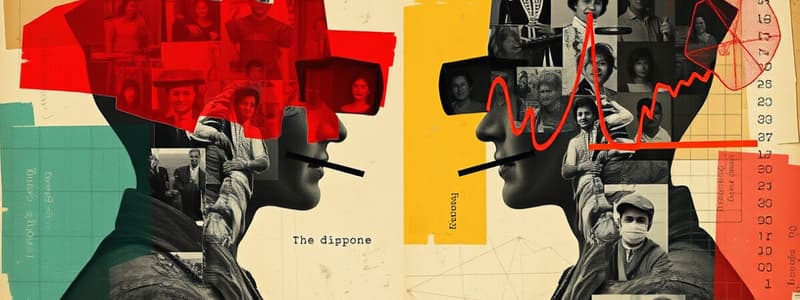Podcast
Questions and Answers
Which of the following factors is least likely to influence an athlete's psychological preparedness?
Which of the following factors is least likely to influence an athlete's psychological preparedness?
- Nutrition (correct)
- Concentration
- Anxiety
- Confidence
What is a primary benefit of using fitness testing for health-related physical fitness?
What is a primary benefit of using fitness testing for health-related physical fitness?
- Comparison to normative data (correct)
- Improvement of technical skills
- Identification of nutritional needs
- Enhancement of psychological resilience
Which tool is primarily used for analyzing biomechanics in an athlete's performance?
Which tool is primarily used for analyzing biomechanics in an athlete's performance?
- Video analysis (correct)
- GPS data
- Fitness testing
- Goal setting sheets
Which aspect of goal setting does the 'A' in S.M.A.R.T. stand for?
Which aspect of goal setting does the 'A' in S.M.A.R.T. stand for?
The use of which type of device can aid in tracking an athlete's sleep and recovery?
The use of which type of device can aid in tracking an athlete's sleep and recovery?
Which method is NOT mentioned as a strategy for skill and technique development?
Which method is NOT mentioned as a strategy for skill and technique development?
In assessing nutritional intake, which of the following is considered a valuable tool?
In assessing nutritional intake, which of the following is considered a valuable tool?
What is a characteristic of a SMART goal?
What is a characteristic of a SMART goal?
What is the purpose of using self-reflection in performance assessment?
What is the purpose of using self-reflection in performance assessment?
Which statement about objective data is true?
Which statement about objective data is true?
Which of the following statements accurately defines a goal within the context of performance assessment?
Which of the following statements accurately defines a goal within the context of performance assessment?
Why is it important for an athlete's goals to be realistic?
Why is it important for an athlete's goals to be realistic?
How is subjective data primarily evaluated?
How is subjective data primarily evaluated?
An example of an aesthetic performance would involve which of the following?
An example of an aesthetic performance would involve which of the following?
What defines an artistic performance?
What defines an artistic performance?
What can happen if an athlete does not set a time frame for their goals?
What can happen if an athlete does not set a time frame for their goals?
Which of the following is NOT a characteristic of aesthetic performances?
Which of the following is NOT a characteristic of aesthetic performances?
In terms of performance assessment, which aspect reflects objective data?
In terms of performance assessment, which aspect reflects objective data?
What type of goals should an athlete strive to set?
What type of goals should an athlete strive to set?
Flashcards are hidden until you start studying
Study Notes
Factors Influencing Performance
- Skill and Technique Development: Utilize video analysis, skill feedback sheets, extrinsic feedback, and performance profile wheels to refine skills.
- Data Collection Methods: Implement wide angle cameras and GPS data for comprehensive performance analysis, along with self-reflection and statistic sheets.
- Physical Fitness Evaluation: Conduct health-related and performance-related fitness testing, comparing results against normative data for benchmarking.
- Psychological Preparedness: Assess factors like confidence, anxiety, motivation, and concentration using tools like the Sports Competition Anxiety Test (SCAT) and Sports Motivation Scale.
- Nutrition Tracking: Use food diaries to monitor intake; applications like MyFitnessPal assist in tracking calories and macronutrients.
- Communication: Engage in discussions with coaches and teammates to understand roles and relationships affecting performance.
- Biomechanics Analysis: Leverage video analysis tools like Hudl and Coach’s Eye to evaluate technique through angle analysis.
- Physiological Demands: Monitor recovery and sleep patterns using wearable trackers such as Whoop and Fitbit, alongside RPE scales and training diaries.
- Choreography Evaluation: Gather insights through observations from coaches and athletes, supplemented by video analysis.
Goal Setting
- Purpose of Goals: Goals provide motivation, establish clear targets, reduce stress through realistic timeframes, and simplify progress tracking.
- S.M.A.R.T Goals Framework:
- Specific: Clearly define what you want to achieve.
- Measurable: Ensure progress can be tracked and measured.
- Achievable: Set challenging yet attainable goals to avoid frustration.
- Realistic: Goals should be feasible considering the athlete's capabilities.
- Time-bound: Set deadlines to maintain motivation.
- Example of a SMART Goal: Aim to increase cardiovascular endurance from 1800 metres in 12 minutes to 2200 metres in 12 minutes within six weeks.
Artistic and Aesthetic Performances
- Definitions:
- Aesthetic Performance: Focuses on the beauty of a performance.
- Artistic Performance: Showcases natural or creative skills for aesthetic pleasure.
- Data Types:
- Objective Data: Involves measurable metrics (e.g., time, distance) that provide consistent results regardless of observer perspective.
- Subjective Data: Assesses creativity and aesthetics based on personal insights, often lacking reliability due to its dependent nature on individual opinions.
- Performance Characteristics: Artistic performances emphasize creative skill application, while aesthetic performances prioritize visual enjoyment.
Studying That Suits You
Use AI to generate personalized quizzes and flashcards to suit your learning preferences.




